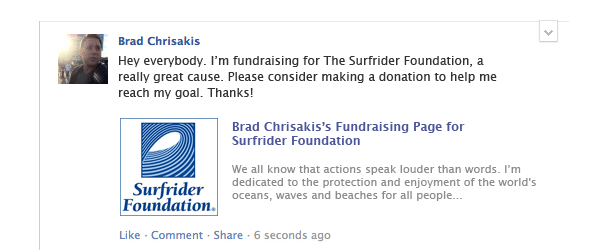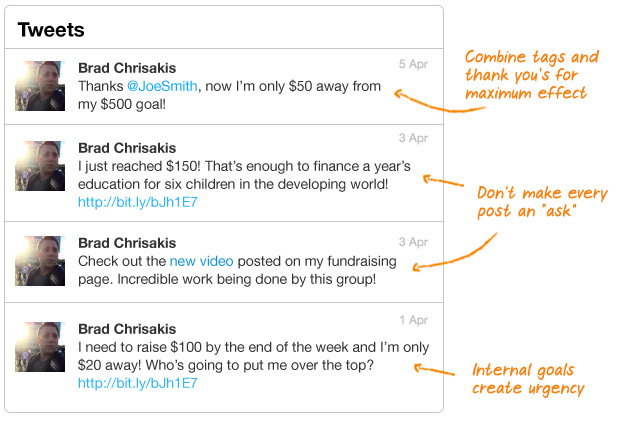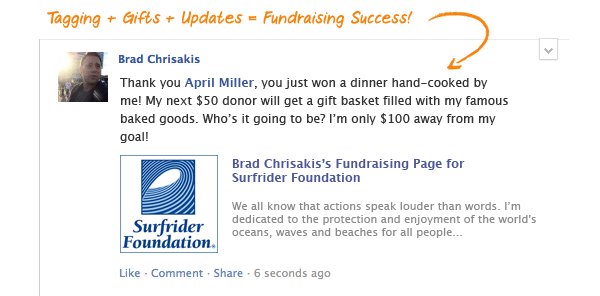The 4 Most Effective Social Fundraising Techniques

Request a Demo
Learn how top nonprofits use Classy to power their fundraising.
The great promise of “social fundraising” is the ability to reach more people, in less time, through popular online platforms like Facebook or Twitter. In theory, this expanded reach should lead to increased participation and higher fundraising returns. In practice, it doesn’t always turn out that way.
Like all other forms of fundraising, social fundraising can be done well or it can be done poorly. From our perch here at Classy, we’ve been able to observe some of the factors that distinguish faltering social fundraising efforts from successful ones. Keep the following tips in mind the next time you try to raise money through social media.
1. The “Direct Ask” Problem
The “direct ask” is the most common way that people share fundraising pages through their social media accounts. Usually they’ll say something like this:

It seems straightforward enough. It seems like it should work. Unfortunately, it usually doesn’t.
There’s a common psychological phenomenon called the “bystander effect” that happens when a group of people collectively fails to help someone in need. We’ve all heard stories of people needing medical attention being passed by throngs of seemingly uncaring pedestrians. The problem is that the people passing by tend to think, “It’s not a big deal if I don’t help, there are so many other people here that someone inevitably will.” With everyone thinking this way, no one winds up helping. That’s the bystander effect.
Something similar to the bystander effect appears to happen in the social fundraising context when fundraisers only rely on direct asks. If you put an appeal for donations out to your 500 friends on Facebook, it’s easy for each individual friend to ignore the request because they assume that one of the other 499 people will help you out. While direct asks absolutely have a place in social fundraising, to really pay off, they need to be integrated into other, more effective, strategies.
2. Tag and Thank
The “Tag and Thank” method is one of the most effective social fundraising approaches we’ve seen. The fundraiser starts out using direct e-mail appeals to get some donations coming in; then, as the donations begin to roll in, the fundraiser tags and thanks each new donor through their social media accounts. It looks something like this:

The Tag and Thank approach is great because it lets you reap the benefits of another common psychological phenomenon- social influence.
Whether we like it or not, we all have a deep drive to conform to the reactions of our peers. When you use the Tag and Thank approach, you are starting out by letting everyone know that people are already donating to your page! By presenting things in this positive way, you are able to use social influence to your advantage.
As your friends see you recognizing more and more donors (people that they likely also know) they will be pushed more and more to get involved. If I see my best friend, or that girl I admire, making a donation to your fundraising page, I’m going to be more likely to make my own contribution.
Read Next: Create a Fundraising Page That Inspires Donations3. What’s the News?
Another great approach is to issue regular fundraising progress updates through your social media accounts. When you pair this approach with internal fundraising goals, you can really start to improve your social fundraising results.
Here’s how it works. Suppose you have four weeks to reach your total fundraising goal of $500. You might set internal goals of $100 for the first week, $250 for the second week, $350 for the third week, and $500 for the fourth week. By creating these sub goals, you can add a sense of urgency to your updates. A series of fundraising progress updates might look like this:

When people tune into your regular progress updates, on some level they begin to follow your “fundraising story.” They become more interested in your success or failure. Instead of repeatedly asking them for money, you are documenting your progress for those involved in your life to see. Framing things this way helps people feel connected to your efforts and can lead people who wouldn’t otherwise contribute to get involved.
4. The Gift Grab Bag
Most people like gifts, no big surprise there. Incorporating gifts into your social fundraising approach, can really help you build a broader base of support. This works especially well when the gifts are personal to the fundraiser. Gifts that require the fundraiser’s particular skills or services tend to inspire more donations because they demonstrate the participant’s commitment to the cause. An example of the Gift Grab Bag approach might look something like this:

Combining the Tag and Thank approach with the Update approach and the Gift Grab Bag approach can really supercharge your social fundraising. While each technique works well in isolation, they work even better in combination. Whether you’re an individual fundraiser or a nonprofit, give them a try in your next social fundraising campaign. We think you’ll be happy with the results!
Every Campaign. Every Channel. #Winning
Subscribe to the Classy Blog
Get the latest fundraising tips, trends, and ideas in your inbox.
Thank you for subscribing
You signed up for emails from Classy
Request a Demo
Learn how top nonprofits use Classy to power their fundraising.
 Explore Classy.org
Explore Classy.org 


